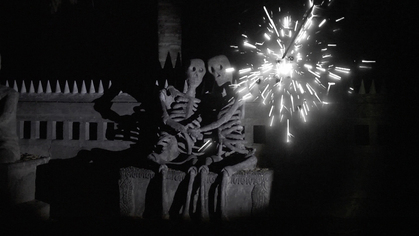-
From Current Issue
-
- Editor’s Letter Fire in the Heart
- Reviews I Gusti Ayu Kadek Murniasih
- Reviews 11th Seoul Mediacity Biennale: “One Escape at a Time”
- Dispatch Networked China
- One on One Monira Al Qadiri on Yukio Mishima
- Essays The rise of independent art spaces in pandemic-era Shanghai
- Features Tuan Andrew Nguyen
- Table of Contents
- Web Exclusives
- Archive
- Subscribe

R
E
V N
E
X
T
Technological media, spiritual beliefs and repressed histories of East and Southeast Asia converged in “Ghosts and Spectres – Shadows of History” at Singapore’s NTU Centre for Contemporary Art (NTU CCA). Lining the corridor of the exhibition were quotes from French philosopher Jacques Derrida’s Spectres of Marx (1993), a seminal text that was responsible for the “spectral turn” in academia. Derrida’s book formed the theoretical scaffolding of the show, providing a vocabulary to engage with the notion of pasts haunting the present. There was much to unpack for curators and audiences alike, as they found themselves in an irremediable mire of colonialism, imperialism and modernity.
Ghosts shock our senses. The exhibition hosted a panoply of videos that were refracted, shattered and split. As opposed to the immersive but static lure of cinema, the abundance of screens at NTU CCA encouraged a perambulatory experience. In Apichatpong Weerasethakul’s Fireworks (Archives) (2014), we see sculptures of mythical creatures from the Buddhist and Hindu cosmology in a garden in northeastern Thailand—a location believed to have been a communist hideout—illuminated by pyrotechnics and strobe lights, inducing a vision that violently teeters between impermeable darkness and blinding flashes. Projected onto a panel of glass, this vision seeps and oozes, with moving images leaking and refracting across the room’s seats and floor. By provoking the viewer’s senses, Apichatpong establishes a correspondence between technological media and the spiritual world, inducing visions that are disembodied or even menacing.
While Fireworks (Archives) was haunted by ocular convulsions, Ho Tzu Nyen’s video installations The Nameless and The Name (both 2015) invoked aural ghostliness: voices without a body and sounds without a source. The Name told the obscure story of ghostwriter Gene Z. Hanrahan, whose words have appeared in an anthology of Ernest Hemingway’s writings and monographs that cover the Malayan Communist Party’s history. The excerpted footage of white male writers mulling over their typewriters clashes with the variegated narration, which oscillates between a chirpy talk-show voice and a lulling, hypnotic drawl. By employing three voice-over artists, Ho destabilizes the authorial power of the singular omniscient voice, in turn interrogating the construction of the Malayan Communist Party’s occluded histories.
Similarly, The Nameless pieced together biographical fragments of Lai Teck, a notorious Sino-Vietnamese triple-agent, who once served as secretary general of the Malayan Communist Party. To lend a face to the portrayal of this clandestine figure, Ho embodied Lai Teck with found footage from films that feature the inscrutable Hong Kong actor Tony Leung. Simultaneously played in two rooms, viewers in the first chamber hear a layered narration in Vietnamese, together with faint echoes of Mandarin Chinese and the occasionally splicing of dialogue in Cantonese. The converse happens in the second room, where one hears a Mandarin Chinese narration with ambient whispers of Vietnamese. The Nameless compels viewers to take on new roles as spies to complete the tale, overturning the passive consumption of stories that we have become accustomed to.
While Apichatpong and Ho confronted Cold War hauntings in Southeast Asia, Park Chan-Kyong invoked specters of national trauma through his panoramic video installation Citizen’s Forest (2016). A gallery of anonymous figures lingered through the disquieting depths of a forest: women in traditional Korean costume, a skull-masked brass band, a body without a head and a head without a body. As though beckoning for closure, these figures represent the nameless victims from major events in modern Korean history, including the traumatic Korean War (1950–53), the Gwangju Massacre that killed up to 606 demonstrators who were responding to the violent treatment of university students by government troops (1980), and the recent Sewol Ferry disaster (2014). These ghosts were exorcised by shamans in a ritual designed to welcome confrontations with repressed history, critiquing the turgid culture of memorialization in contemporary Korean society.
Excursions into repressed histories are also found in Nguyen Trinh Thi’s film Love Man Love Woman (2007), which follows the flamboyant, sharp-tongued Luu Ngoc Duc, a prominent spirit medium of dong co (“woman’s spirit”), as he shares insights on dao mau (“mother goddess worship”). Spirituality provided sanctuary for effeminate gay men like Duc, who is able to straddle between gender boundaries on temple grounds and find affirmation within the community of dao mau devotees. While one would be easily charmed by Duc’s magnetic personality, the film left one feeling ambivalent as he ascribes his gayness to a “disease,” or makes misogynistic claims in order to elevate the spiritual position of effeminate gay men.
Hsu Chia-Wei, whose films will be presented as part of the exhibition’s public programs, told another story of dancing with spirits. For close to half a decade, the artist has been conducting research on the frog god Marshal Tie Jia, a deity currently exiled on the tiny Turtle Island between Taiwan and China, and has documented unusual interactions with the frog god in his films. After a misstep by Hsu that ignited the Marshal’s rage, leading to a two-year-long research hiatus, the artist came to the understanding that the Marshal was not a mere metaphor, but an actual entity to be accorded proper care—a necessary disposition for dances those who wish to waltz with ghosts.
“Ghosts and Spectres – Shadows of History” is on view at NTU Centre for Contemporary Art Singapore until November 19, 2017.
To read more of ArtAsiaPacific’s articles, visit our Digital Library.









